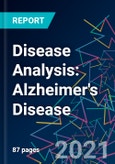Disease Overview
Alzheimer’s disease is an irreversible, progressive, neurodegenerative disease that slowly affects memory, cognition, and function. It is a continuum of pathological changes in the brain that begin well before clinical symptoms emerge. The hallmark abnormalities of Alzheimer’s disease are beta-amyloid deposits and tau tangles in the brain, while it is also characterized by the loss of neuronal connections. These pathological changes are thought to occur years in advance of the onset of dementia in patients with Alzheimer’s disease. Studies indicate that people aged 65 years and over survive an average of four to eight years after a diagnosis of Alzheimer’s disease, yet some live as long as 20 years or more, indicating the slow, insidious progression of the disease.
Latest Key Takeaways
Alzheimer’s disease is an irreversible, progressive, neurodegenerative disease that slowly affects memory, cognition, and function. It is a continuum of pathological changes in the brain that begin well before clinical symptoms emerge. The hallmark abnormalities of Alzheimer’s disease are beta-amyloid deposits and tau tangles in the brain, while it is also characterized by the loss of neuronal connections. These pathological changes are thought to occur years in advance of the onset of dementia in patients with Alzheimer’s disease. Studies indicate that people aged 65 years and over survive an average of four to eight years after a diagnosis of Alzheimer’s disease, yet some live as long as 20 years or more, indicating the slow, insidious progression of the disease.
Latest Key Takeaways
- The publisher estimates that in 2018, there were 74.5 million prevalent cases of Alzheimer’s disease in adults aged 65 years and older worldwide, and forecasts that number to increase to 102.5 million prevalent cases by 2027.
- The US Alzheimer’s disease market only includes four franchised products that are well established. The acetylcholinesterase class of drugs will continue to dominate the treatment of mild Alzheimer’s disease, while NMDA receptor antagonist memantine is used primarily as an add-on or second-line therapy in more severe disease stages.
- Generic erosion has led to the contraction of the overall Alzheimer’s disease market. This may be slightly offset by increased prevalence owing to an aging population and advances in screening for the earliest phases of Alzheimer’s disease that may lead to improved diagnosis rates, with potential growth also possible from the anticipated anti-amyloid antibodies.
- Biogen’s unexpected decision to pursue FDA approval for its previously discontinued amyloid-targeting biologic aducanumab in Alzheimer’s disease was met with skepticism given the surprising nature of the turnaround. Despite a promotional attitude from the FDA neurology division’s clinical team, it is by no means clear that the drug will skate through the FDA approval process since an advisory committee meeting came up negative. Even if the drug is approved, it is uncertain how patients, physicians, and payers might weigh the potential cost of the drug against what could be viewed as incremental efficacy. Regardless, the approval of an anti-amyloid antibody has the potential to transform the Alzheimer’s disease market.
- In late 2019, China granted a conditional approval for GV-971, an oligosaccharide derived from brown algae, representing the first novel drug approved for Alzheimer’s disease in nearly two decades.
- Results from Phase III clinical trials for beta amyloid-targeting antibodies lecanemab and gantenerumab are not expected until 2022.
- The likelihood of approval of a Phase III Alzheimer’s disease asset is less than 20%, compared to nearly 50% in the overall neurology space.
Table of Contents
OVERVIEW
DISEASE BACKGROUND
TREATMENT
KEY REGULATORY EVENTS
CLINICAL TRIAL LANDSCAPE
LICENSING AND ASSET ACQUISITION DEALS
DRUG ASSESSMENT MODEL
FUTURE TRENDS
RECENT EVENTS AND ANALYST OPINION
KEY OPINION LEADER INSIGHTS
UNMET NEEDS
LIST OF FIGURES
LIST OF TABLES








